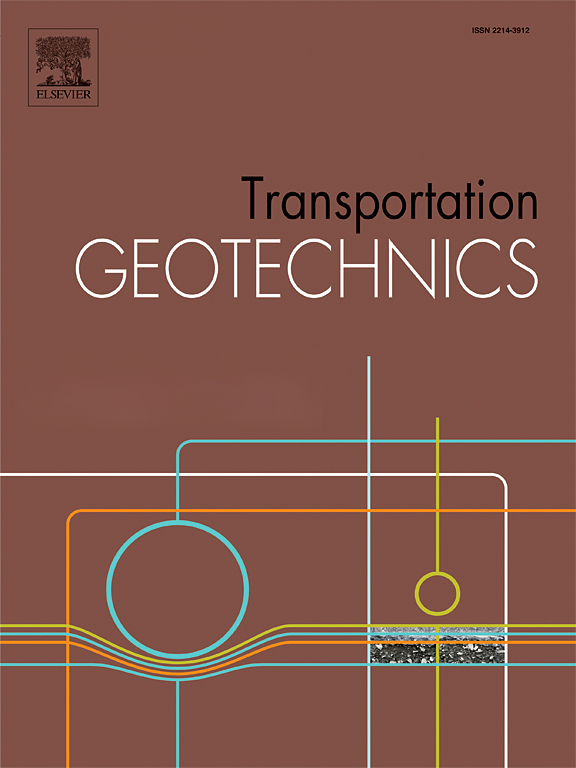通过新型过渡结构的几何优化实现铁路过渡区的能量再分配
IF 4.9
2区 工程技术
Q1 ENGINEERING, CIVIL
引用次数: 0
摘要
铁路过渡区是铁路基础设施中的关键区域,由于能量集中在这些区域内,这些区域会受到过度运行驱动的退化影响。本研究提出了一种启发式方法来优化过渡结构的几何形状,并研究其对铁路过渡区(RTZ)应变能分布的影响,特别关注配备了新提出的 "安全船体激励限能设计(SHIELD)"过渡结构的路堤-桥梁过渡区。为此,我们使用了大量三维有限元模型对 SHIELD 的不同几何轮廓进行了系统分析。通过改变 SHIELD 在纵向、横向和垂直方向上的几何形状,从空间和时间变化的角度研究了不同几何形状对路基各层(道碴、路堤和路基)总应变能分布的影响。研究结果确定了几何形状对所有三个方向的能量再分布的影响,并为所研究的过渡类型提出了最佳几何形状。研究发现,在所有剖面中,SHIELD 的纵向几何剖面对应变能分布的影响最为显著,而横向剖面主要影响压载层,垂直剖面的改变则增强了过渡界面附近应变能的局部再分布。本研究提出的初步优化(启发式方法)为全面优化提供了起点,以获得量身定制的过渡结构形状,从而既不会造成能量集中,也不会阻碍 RTZ 中的能量流动。本文章由计算机程序翻译,如有差异,请以英文原文为准。
Energy redistribution in railway transition zones by geometric optimisation of a novel transition structure
Railway transition zones are critical regions in railway infrastructure that are subjected to excessive operation-driven degradation due to energy concentration within these zones. This work presents a heuristic approach to optimise the geometry of the transition structure and investigate its influence on the strain energy distribution in the railway transition zones (RTZs), with a specific focus on embankment-bridge transitions equipped with a newly proposed ’Safe Hull-Inspired Energy Limiting Design (SHIELD)’ transition structure. For this purpose, a number of three-dimensional finite element models are used to analyze different geometric profiles of SHIELD in a systematic manner. By altering SHIELD’s geometry across longitudinal, transversal, and vertical directions, the influence of the different geometric profiles on the total strain energy distribution across the trackbed layers (ballast, embankment, and subgrade) is studied in terms of spatial and temporal variations. The results establish the contribution of geometry to energy redistribution in all three directions and present an optimum geometry for the type of transition under study. It is found that among all the profiles, the longitudinal geometric profile of SHIELD has the most significant impact on the strain energy distribution, while the transversal profile primarily influences the ballast layer, and the alteration of vertical profiles enhance the local redistribution of strain energy in the vicinity of the transition interface. The preliminary optimisation (heuristic approach) presented in this work provides the starting point for full-scale optimisation to obtain tailored shapes of transition structures such that there is neither a concentration of energy nor an obstruction in the flow of energy in RTZs.
求助全文
通过发布文献求助,成功后即可免费获取论文全文。
去求助
来源期刊

Transportation Geotechnics
Social Sciences-Transportation
CiteScore
8.10
自引率
11.30%
发文量
194
审稿时长
51 days
期刊介绍:
Transportation Geotechnics is a journal dedicated to publishing high-quality, theoretical, and applied papers that cover all facets of geotechnics for transportation infrastructure such as roads, highways, railways, underground railways, airfields, and waterways. The journal places a special emphasis on case studies that present original work relevant to the sustainable construction of transportation infrastructure. The scope of topics it addresses includes the geotechnical properties of geomaterials for sustainable and rational design and construction, the behavior of compacted and stabilized geomaterials, the use of geosynthetics and reinforcement in constructed layers and interlayers, ground improvement and slope stability for transportation infrastructures, compaction technology and management, maintenance technology, the impact of climate, embankments for highways and high-speed trains, transition zones, dredging, underwater geotechnics for infrastructure purposes, and the modeling of multi-layered structures and supporting ground under dynamic and repeated loads.
 求助内容:
求助内容: 应助结果提醒方式:
应助结果提醒方式:


